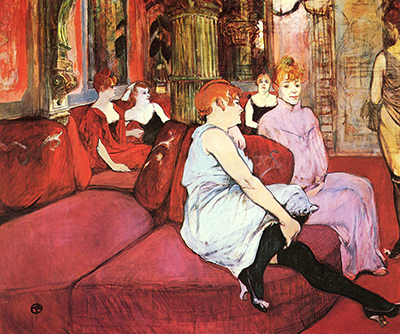Henri de Toulouse Lautrec started painting in the 1890s. His inspiration was the distractions that the city of Paris had to offer like the tracks, the brothels and the circuses.
Although he demonstrated most of his works through the city's distractions, he never painted vulgar, venal, or obscene prostitutes which were favourites of other painters. In 1893, he painted the Au Salon. This painting is a depiction of the Rue des Moulins' house number 6 that was located in the opera of Paris. The Au Salon is an oil on canvas painting that is on a 112cm x 133cm canvas. This painting demonstrates the everyday life of the prostitutes who are immobile, idle, and impassive in their off-peak hours waiting for a client. On the right, we see one of them going through a medical check-up which was not a colourful experience.
In Salon of Rue des Moulins, one of the girls in the Rue d’Amboise brothel was Mireille. She was a favourite to Lautrec. In the salon painting, she can be seen sitting in the foreground with her leg drawn up and her right hand on it. Most of the women are all gazing at the salon customers with a strict gaze. Mireille never worked at the Rue des Moulins; she worked at the Rue d’Amboise. Lautrec only visited Rue des Moulins on a frequent basis after Mireille travelled to Argentine.
In the years between 1892 and 1895, Toulouse Lautrec painted more than fifty paintings. More than a hundred paintings were based on the brothels. This is the most famous painting of them all. In this painting, Lautrec relied more on his imagination and memory. He used sketches and jottings to bring the characters to life in this painting. He managed to produce this art piece after a few months in his studio.
In Salon of Rue des Moulins, the setup is cosy, thanks to the comfortable purple divans that make the audience feel close to the women. We can see the lines on their faces that have been greatly portrayed. The woman in the painting are silent, they all have reddish hair, and they look passive and lifeless. The general feel of the painting creates an atmosphere where the ladies seem to have resigned into a fatal lifestyle. Toulouse Lautrec knew these environments because he made regular visits. He must have felt some affection to these women. They don’t seem to exude some erotic enthusiasm nor do they look melancholic. The painting shows the ambiguity of the place that Lautrec does not judge. The painting is now located in the Musee Toulouse-Lautrec, Albi, France.




